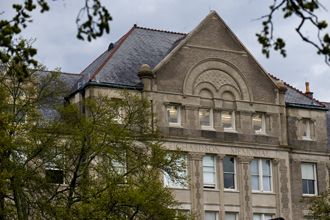Talking Buildings in Tulane's Future
Imagine a future where buildings are smart enough to “talk” at least to tell you when you are wasting precious natural resources and need to adjust temperature, water consumption, power or lighting. The Tulane University School of Architecture has teamed up with IBM to launch a pilot program to do just that, by uniting computer technology with green building practices.

Built in 1908, Richardson Memorial Hall will be the first Tulane building in a pilot program that unites computer technology and green building practices. (Photo by Paula Burch-Celentano)
Richardson Memorial Hall, the home of the School of Architecture, will be the first Tulane building to go online in the pilot program, officially called “Smart Building Solutions.” Technology is being installed in the building now, with an eye toward a future renovation project.
“Richardson Memorial will undergo a major renovation starting in a few years,” says architecture dean Kenneth Schwartz. “The challenge for us is to take a structure that's over 100 years old and make it smarter, more efficient and effective in the way it operates.”
According to Schwartz, Tulane's opportunity to participate in the program came about thanks to Randall Dalia, an IBM executive who is an alumnus of the architecture school and the A. B. Freeman School of Business.
Two Tulane departments are involved in the project technology services will oversee the computer programming and databases, while facilities services will manage the building.“We're operating under the mantra, 'If you can't measure it, you can't manage it,”' says Charlie McMahon, Tulane's chief technology officer. “We'll be able to collect data about usage and incorporate what we learn into the renovation project so we can have a more energy efficient building when we are done.”
McMahon says that Richardson Memorial will serve as a “living laboratory” for the architecture faculty and students to see firsthand the impact of building energy management techniques into a historic structure. Says McMahon, “They'll learn about what works and doesn't work in energy management in an older building like Richardson.”
